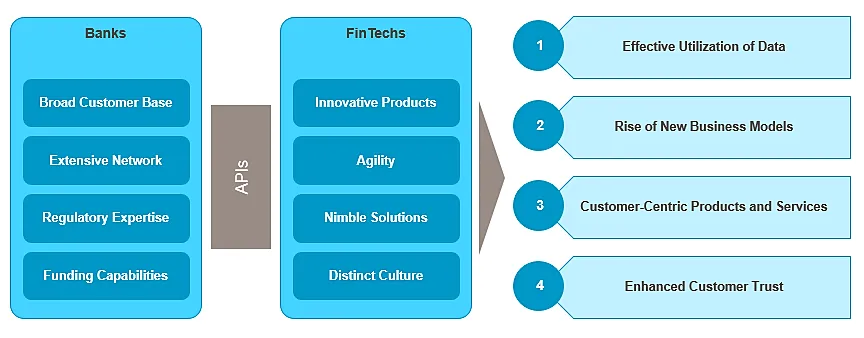APIs Enable Bank/FinTech Collaboration
Blog: Capgemini CTO Blog
The pressures of rising costs, high-impact regulations, rapidly evolving customer expectations, and the growing acceptance of FinTechs may well be keeping bank executives up at night. But now, incumbents must contend with the effects of disruption as well as the threat of disintermediation.[1] What’s more, FinTech entrepreneurs have their own set of challenges. They have yet to earn customers’ deep trust, they haven’t established a distribution infrastructure, and their customer base—while growing—pales in comparison with incumbent banks.
So, it makes sense that FinTech/Bank collaboration is a win-win situation as each leverages the other’s strength. Although there was initial resistance to working together, both entities now realize the value collaboration can create for them as well as for end users. According to the 2017 World Retail Banking Report from Capgemini and Efma, an overwhelming 91.3% of bank executives interviewed said they were willing to work with FinTechs and, similarly, 75.3% of the FinTechs said they would collaborate with banks.
APIs: The Great Enablers
More and more, financial institutions are partnering with FinTechs to leverage Application Program Interfaces (APIs) to attract new prospects while positively surprising current customers with enhanced experiences and a range of new personalized products and services.
APIs offer a bridge between systems while paving a digital path to an increasingly connected financial ecosystem. Already trusted by consumers, banks can tap their vast customer data bases to play a central role in this emerging environment. But to deliver the most meaningful customer-experience improvements, banks must reveal their APIs to a global community of web developers to encourage novel idea sharing and exceptional innovation.
The strength of banks rests within their vast customer bases, extensive distribution capabilities, funding proficiency, and regulatory expertise. FinTechs’ core strengths are built on innovative product offerings, agility, and cutting-edge technologies.
It goes without saying that FinTech/bank collaboration can benefit the industry at large, as well as each individual stakeholder. For traditional banks, innovative offerings from partner FinTechs will not only help augment customer experience and cement loyalty with existing customers, but may also spur new business. FinTechs can achieve economies of scale at lower costs by promoting their innovative offerings to the large customer bases of their partner banks. Consumers also benefit because they will now be able to pick and choose products and services based on their preferences and requirements. In short, customers will be able to “design” or customize their financial-services experience.
FinTech/bank collaboration continues to pick up speed, particularly in instant payments, peer-to-peer lending, and credit scoring. Think about it: banking business models are evolving thanks to the synergy between agile tech entrepreneurs and knowledgeable, but sometimes conservative incumbents.

Some recent win-win partnerships include:
- BBVA Compass partnered with Dwolla, an all-digital payments network, so its customers could instantly send and receive funds.[2]
- JPMorgan Chase collaborated with OnDeck, a leader in online small-business lending, to offer a proprietary credit score based on loans granted to small- and mid-tier corporates.[3]
- DBS, a multinational bank headquartered in Singapore, joined forces with peer-to-peer lending sites, funding societies and MoolahSense, to better serve small businesses. In return, the two lending platforms refer borrowers with good credit to DBS for commercial banking solutions such as cash management.[4]
In short, APIs can help to improve customer experience, drive new revenue streams, and reduce time to market for new products and services. And that means the potential to create a value-based marketplace and bolster long-term customer loyalty.
API Considerations
Although APIs offer plenty of benefits, there are risks to consider. Banks must address data security, customer privacy, and control of customer data when entering into (and potentially leading) FinTech collaboration. By their very nature, APIs are intended to make bank information accessible to third parties and, therefore, they can unlock vulnerability to cyber attack. Clearly, robust security standards must be developed to mitigate this danger.
With alarm bells literally and figuratively going off, it is no surprise that 69.5% of banks and 74.1% of FinTechs participating in the 2017 World Retail Banking Report (WRBR) said data security was their primary concern. This was followed by worries about customer privacy, as indicated by 69.5% of banks and 72.8% of FinTechs.
Risk and the apprehension it causes can be mitigated through standardization and controlled implementation of APIs. Banks and FinTechs must agree on an API monetization method as this will be a crucial incentive to collaborate. According to the WRBR 2017, a fee-per-API-transaction model is popular with both banks and FinTechs (43.5% and 54.3%, respectively). Consequently, the pursuit of new business opportunities and more significant market share are expected to trigger both banks and FinTechs to embrace revenue-sharing models in the months ahead.
[1] Disintermediation is the withdrawal of funds from intermediary financial institutions, such as banks, to invest directly. Generally, disintermediation is the process of removing the middleman or intermediary from future transactions.
[2] “BBVA Compass, Dwolla begin rollout of real-time bank transfers,” BBVA Compass, April, 8, 2015; http://newsroom.bbvacompass.com/2015-04-08-BBVA-Compass-Dwolla-begin-rollout-of-real-time-bank-transfers
[3] “JPMorgan Working With On Deck to Speed Small-Business Loans,” Bloomberg, December 2, 2015; https://www.bloomberg.com/news/articles/2015-12-01/jpmorgan-working-with-on-deck-capital-for-small-business-loans
[4] “DBS partners p2p platforms,” Let’s Crowd Smarter, April 19, 2016; http://letscrowdsmarter.com/dbs-partnership/